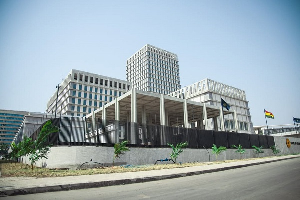That malaria represents both a national and even global public health burden is not in doubt. It has been identified as key in achieving five of the eight millennium development goals. The direct and indirect costs of malaria in Africa exceed US$2 billion a year while accounting for a reduction of 1.3% of the annual economic growth rate. A study in 2003 by Asante et al revealed that nine workdays were lost by economically active people who were ill with malaria; while more than five workdays were lost by their caretakers.
Of course, the classic example provided by AngloGold Ashanti’s indoor residual spraying (IRS) programme in Obuasi with documented evidence on reduced malaria morbidity and economic burden provides the necessary impetus to spur corporate action and commitment to tackle the malaria burden.
In Ghana, the statistics as supplied by the NMCP are no less staggering. Established as the leading cause of illness, it causes about 8,200 cases daily and 3,000,000 illnesses every year with over 3000 deaths in 2010. As high mortality as this is, the NMCP is quick to point out that this represents a steady drop from the 40, 000 deaths reported ten years ago. The most vulnerable groups remain children under five years of age, pregnant women and non-immunes.
History of control
As far back as pre-independence Ghana, malaria control has been high on the agenda with interventions including indoor residual and aerial spraying plus addition of chloroquine to salt in the 1950s. Between 1996 and 1997, the focus remained accelerated malaria control through better case management with prompt treatment. This continued till 1998 when the “Roll Back Malaria” initiative was adopted as a combination of preventive and curative measures.
Current malaria control
While current interventions do not differ substantially in scope, there has been a refocusing of efforts with a few specific interventions tweaked.
Multiple prevention
A suite of multiple prevention measures have been outlined including not just free distribution of insecticide treated nets (ITNs) but actual door-to-door campaign to hang these nets by community-based volunteers to enhance usage. A post evaluation survey undertaken after one such campaign in the Northern Region indicates that the number of children under five sleeping in the net increased from 26.7% (DHS) to 81.1% and also 7% to 39.5% for pregnant women. To support its insistence on ITN-use, the NMCP provided W.H.O. (World Health organization) data that shows a reduction in the levels of parasites found in the blood of children under-five years, who demonstrated increasing net use. Further, if data from the Ghana Demographic Health Surveys of 2003 and 2008 are anything to go by, ITN- use advocacy would seem to be working with significant documented increases in utilization in children under five and pregnant women. Malaria in pregnancy which is a documented cause of death has been targeted with three doses of SULPHADOXINE-PYRIMETHAMINE (popularly known as SP) scheduled to be administered under the direct observation of health professionals between the fourth and ninth months of pregnancy. Data also exists to show that with increasing SP coverage, more and more women are protected from malaria in pregnancy.
In addition to AngloGold Ashanti’s exploits, the US President’s Malaria Initiative (PMI) is currently piloting a scalable indoor residual spraying exercise in nine of the twenty districts of the Northern Region. Environmental management has been frequently advocated for at the community level while targeted larviciding has been deployed on a limited scale in parts of Greater Accra and Volta Regions under the support of a Cuban Government partnership project. Research into malaria vaccines is reported to be on going in places like Agogo, Kintampo and Noguchi Memorial Research centres with an optimistic five year time line for a possible malaria vaccine deployment.
Curative measures
While chloroquine used to be the treatment of choice, the use of Artemisimim-based Combination therapies (ACTs) is now scientifically proven to be more efficacious. On the night in question, Dr Constance Bart-Plange, the Programme Manager called for an enforcement of the ban preventing the importation, manufacture and storage of chloroquine and other ineffective monotherapies in the country adding that “drugs which can’t treat malaria still exist in pharmacies and licensed chemical shops in the country.”
In addition, the program is promoting the use of rectal artesunate as a pre-referral treatment for severe malaria in children under five years while scaling up home based care nationwide.
Under a new co-payment arrangement between the government of Ghana and the Global Fund, an Affordable Medicines Facility for Malaria (AMFm) platform has been rolled out in an attempt to remove cost as a barrier to appropriate malaria treatment. A full treatment course for children and adults is supposed to cost 40 – 80 Ghana pesewas and GH¢1.00 - 1.50 respectively. In the light of evidence that ACTs are still being sold at, sometimes, ten times this stated cost, perhaps new efforts need to go into how to make anti malarials more accessible to those who really need them.
Here too, the data indicates a consistent unbroken trend of reducing under five mortality due to malaria between 2003 and 2010.
Challenges
The modest advances notwithstanding, a number of challenges remain. The evidence on the merits of ITN use notwithstanding coupled with the relatively high awareness and ownership of nets, nationwide usage is as low as 28% among children under 5 years and 20% among pregnant women (DHS 2008), obviously a far cry from the 80% target. The reasons for this gap are known; associated heat, discomfort and by far the most inventive, “making people who sleep in ITNs feel like corpses!”
Misconceptions fueled by ignorance about the causes of malaria have not helped the situation much. There are still a significant proportion of people who attribute malaria to “transfer body heat via breast milk when mothers breastfeed their babies, or eating unripe mangoes …” or through “prolonged playing in the sun by children”. The plasmodium falciparum transmitted through the bite of the female anopheles mosquito has obviously been left off the hook.
Ghanaian researchers are making a serious case for misdiagnosis of malaria with its attendant wrong treatment and implied over-consumption of anti malarials. Health professionals may need to reach consensus on this based on available evidence and determine the best way forward in the patients’ best interests. A study conducted at sentinel sites nationwide revealed that over 60% of suspected cases of malaria were not confirmed to be real cases of malaria after tests through rapid diagnostic kits and microscopy. A conversation needs to occur on the implications and feasibility of testing every suspected case of malaria on our current human resource strengths and the implications for laboratory turnaround times in particular and patient waiting times in general.
Future
According to NMCP, specific opportunities for corporate Ghana to contribute are in procuring ITNs for free distribution to their staff, liaising with the program to implement IRS (indoor residual spraying) programs, procurement of rapid diagnostic test kits and the approved antimalarials to ensure that malaria is diagnosed and treated correctly in particular communities and clinics. Others include setting up workplace Malaria Control Programs, providing desks with information on malaria prevention, education of staff on environmental management, branding of company products with malaria information, engaging local celebrities to champion malaria advocacy/concerts on malaria, supporting innovations on malaria...research into vaccines, Insecticide-treated wall lining, cloths, etc
The future belongs to thinking outside the box as advocated in a speech delivered by Dr George Amofa, Deputy Director General of the Ghana Health Service at the afore-mentioned dinner. Targeting policy makers and scientists, he made four specific suggestions; for the country to increase local funding for scientific solutions to malaria in Ghana, the need to consider mass drug administration prior to the onset of peak transmission periods, the expansion of larvicidal programmes nationwide and investment in other biological control measures such as genetic modification of the mosquito? On this last point, scientists appear to be making headway if reports monitored on the BBC are anything to go by.
“Scientists believe they are closer to being able to change the DNA of wild mosquitoes in order to combat malaria. In the laboratory, they made a gene spread from a handful of mosquitoes to most of the population in just a few generations, according to a report in Nature. If the right gene can be made to spread, then researchers hope to reduce the number of cases of malaria.”
Sodzi Sodzi –Tettey
Visit the writer’s blog @ www.sodzisodzi.com
Opinions of Friday, 13 May 2011
Columnist: Sodzi-Tettey, Sodzi














